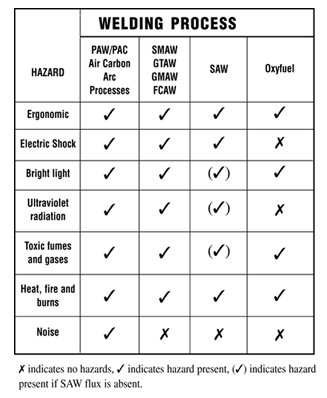Welding - Overview of Types and Hazards
On this page
What is welding?
Back to topWelding is a joining process in which metals, or sometimes plastics, are heated, melted and mixed to produce a joint with properties similar to those of the materials being joined.
There are three main components needed to create a weld. These are:
- A heat source such as an electric arc, a flame, pressure, or friction. The most common heat source is an electric arc. An arc is the physical gap between the end of the electrode and the base metal. The physical gap causes heat due to resistance of current flow and arc rays. The arc melts the metals to create the joint.
- Shielding, which is the use of gas, or another substance to protect the weld from air as the weld is being formed. Oxygen from the air makes welds brittle and porous.
- Filler material, which is the material used to join to the two pieces together.
Other processes that join metals together include:
- Brazing is the joining of metals with a filler metal having a melting point above 450°C (842°F), but below the melting point of base metals. The joined metals can be different metals. The joint is not as strong as a welded joint.
- Soldering is the joining of metals using a filler metal with a melting point below 450°C (842°F). The joined metals can be different metals. The "filler" metals commonly used are lead-tin alloys. The joint is not as strong as a welded joint or a brazed joint.
Is there more than one type of welding process?
Back to topThere are over 70 different welding processes. The type of welding process used is related to the specific application. The most common processes are:
- Shielded Metal Arc Welding (SMAW), also known as Manual Metal Arc Welding, MMAW.
- Gas Tungsten Arc Welding (GTAW) or Tungsten Inert Gas (TIG) Welding.
- Flux Cored Arc Welding (FCAW).
- Gas Metal Arc Welding (GMAW), also known as Metal Inert Gas (MIG) Welding or hard wire welding.
- Plasma Arc Welding (PAW), Plasma Arc Cutting (PAC) and Gouging
- Submerged Arc Welding (SAW)
- Resistance Spot Welding (RSW) or spot welding.
- Air Carbon Arc Cutting (CAC-A) and Air Carbon Arc Gouging (CAG)
- Oxyfuel Gas Welding (OFG), Cutting and Heating (oxygen-acetylene [oxyacetylene] (OAW) or oxygen-propane [oxy-propane] mixtures are the most common fuel mixtures used).
What, in general, are the hazards associated with welding?
Back to topHealth hazards associated with welding, cutting, and brazing operations will depend on the composition and exposure level to welding fumes and gases, and to ultraviolet (UV) radiation. Health risks include respiratory irritation, metal fume fever, lung cancer, skin cancer, damage to the nervous system, asphyxiation, and other health risks.
Safety hazards associated with these processes include burns, eye damage, electrical shock, cuts, injury to toes and fingers. Fires and explosions may also occur.
Many of these hazards can be controlled with elimination and substitution controls (e.g., eliminate need for welding or using a using lower fume-generating welding process), engineering controls (e.g., local exhaust ventilation), work practices (e.g., remove coatings before welding, and worker training), and personal protective equipment (PPE)(e.g., respiratory protection).
Risk assessments and occupational hygiene air sampling can be performed to determine health and safety risks and worker exposures, and to help identify the control measures that are needed.

- Fact sheet last revised: 2021-10-29
